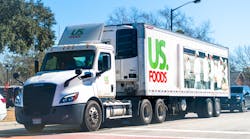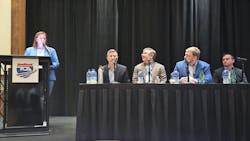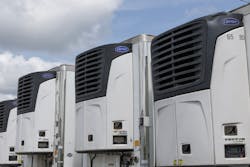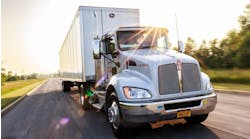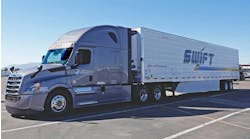Reefer reconfiguration: TRU tech is evolving—and suppliers aim to help
PARK CITY, Utah—Transport refrigeration unit (TRU) technology is changing rapidly, leaving manufacturers and fleets alike scrambling to meet ever-evolving regulations—and head-spinning zero-emission timelines. Carrier Transicold recently expanded its CARB-compliant line of all-electric reefer units, and Thermo King’s new e1000 all-electric unit collected a prestigious Top Product award in July.
To help carriers keep up, Carrier Transicold and Thermo King executives highlighted impending requirements—and those likely to impact temperature-controlled fleets in the future—transitioning to lower global warming (GWP) refrigerants, the impact of government mandates on manufacturing efforts, and working with local dealers on technician training for the next generation of transport refrigeration equipment during the 2023 Truckload Carriers Association (TCA) Refrigerated Meeting at the Grand Summit Hotel.
“It’s a tough economy, and a tough equipment market with high prices,” Mike Durst, 2022-23 TCA refrigerated division chair and Arctic Express COO, said before introducing new chair Amber Edmondson, Trailiner president and CEO, who moderated the “Technicians, Parts, and Temperature-Controlled Developments” panel with Carrier Transicold’s Bill Maddox and Patrick McDonald, and Thermo King’s Sam Doerr and Larry Risi.
Maddox, a senior product manager, boasts 25 years of experience with Carrier Transicold, and McDonald, senior manager of product services engineering, has been with the company 26 years. Doerr, Thermo King’s trailer portfolio leader, is a 15-year transportation industry veteran, and Risi, strategic account manager, has 30 years in transportation.
Questions and answers are edited for length and clarity.
Edmondson: Where do we stand today with transport refrigeration units?
Maddox: CARB [the California Air Resources Board] recently amended the regulation they have in place regarding TRUs. And so, from an equipment perspective, I would group it into three main categories they looked at. One was lower GWP [global warming potential] refrigerant, another was setting a lower PM requirement for the engines, regardless of horsepower class, and then one that doesn’t necessarily affect this group immediately—but gives us a window into what they may do in the future—is on medium-duty trucks, and it’s driving toward zero-emission TRUs in that application size. That’s beginning at the end of 2023, where fleets in that class range need to convert 15% of their equipment to zero-emission technology, instead of having a diesel-powered TRU.
See also: Temperature-controlled fleets flock to Utah
Doerr: There is some confusion with this regulation. It went into effect at the beginning of the year, and we get a lot of questions about one of the provisions around TRU OEM manufacturing ability for the 2022 engines that are carryovers. In that regulation, there’s a provision that allowed us to manufacture 2022 engines into units until May 31 of this year. That only has to do with us, and that regulation is there to help us with the inventory we have in stock. In any given year, we may be carrying 2022 engines over. So it has nothing to do with trailer OEMs or our customers. It’s just a requirement for us to take those engines and put them into units by that date. Also, there have been regulations in the straight-truck market for TRUs, and that will have an influence on what happens in our space. And there also has been regulation, just recently, on the tractor side, where they’ve pushed out, and granted leniency, on some of the tractor requirements. So there are a lot of things happening with CARB that could really impact our space.
Edmondson: So, what does CARB have in store for us in the near term, say over the next five years, as far as upcoming requirements?
Maddox: From CARB’s perspective, they call what they’ve implemented for this year Phase 1. So they started off with medium-duty straight trucks going zero emissions. Now they’re going to be turning their focus onto trailers that are operating in the state of California. So they have a mandate from the governor that anything operating in the state—not just trailers—needs to be zero-emission technology by 2035. So with this provision they did on trucks, with the phase-in, that’s where we think they’re going to go with trailers—a 15% phase-in, with 2035 as the end goal for 100%. And zero emissions can be hydrogen or battery power, anything like that. So there’s still a lot of dialogue to have with them on what those solutions can be.
Doerr: As confusing as CARB can be, they do have clear documentation on their website. So if you go into their FAQ document, which is on the front page of the CARB TRU page, you can look at what they’re saying. The latest date they’ve said is 2027, so they’ve pushed it back a year. So if you go back to last year’s act, that was the first time they talked about their Phase 2 rollout. And since then they’ve delayed it and haven’t been super clear. But some things to think about are, if they implement the 15% rule on trailers, that will mean 100% of our capacity as manufacturers would have to go to these electric trailers. So there are things they’re going to have to work through in terms of the rollout for us to be able to make this possible on a go-forward basis.
Then on the tractor side, they pushed out the latest regulations and guaranteed a four-year transition to zero emissions, at a minimum, once it goes into effect, and you could think that’s possibly something they may do for trailers. And there are gray spaces in what the regulation is going to say. We see a lot about range-extension technologies, but so far, we have no indication of what the regulation is going to say about them. So there’s a ton of unknown in this space related to zero emissions.
Maddox: When they really start making this rulemaking public, maybe at the end of this year, [refrigerated carriers] will play a key part in getting feedback to them. There are avenues for that, through the American Trucking Associations, and California Trucking Association. They have lobbyists who engage with them. You’re an important voice. We can talk about what we can or can’t make from a manufacturer’s standpoint, but your ability to utilize the equipment is key.
Edmondson: How have these ongoing threats of regulation from CARB, EPA, and other states forced manufacturers to adapt, and how is it impacting product development decisions and what’s available out there?
Doerr: TK has had a CARB-compliant unit for over a decade. So our focus has been on thinking about what it means to better integrate things like shore power. So, we’re seeing an uptick in the take rate on shore power, and for multi-temp units; and that’s where we put a lot of energy in terms of investment. So TK is rolling out a new unit for multi-temp in the next year and that is focused on supporting interim steps to zero emissions. That’s the way we’re thinking about the future. What’s the roadmap to get us to zero emissions? It can’t be all or nothing. The other area where we maintain focus is with our current units. We know diesel prices are fluctuating and some of this CARB regulation stuff is noise. So ultimately, we continue to focus on the things that provide the best TCO.
Maddox: From a Carrier perspective, we look at regulatory compliance as a key that drives a lot of our product development. But we also want to offer benefits besides compliance. So we’re always looking at ways to be more efficient, offer more features to you, or improve fuel economy and weight, and those types of things. And with some of these regulatory changes, with our engines and the horsepower required, we’re introducing new models to meet CARB regulations. We don’t like to say they’re CARB evergreen, because they keep changing the rules, but they are compliant today, as the rules are written. But we’re continuing to develop our technology. Electrification of the TRU is going to be key, whether it’s getting electricity from a battery, hydrogen fuel cell or other source. So we continue to invest in that technology and how to best utilize it.
Edmondson: Thermo King and Carrier both have extensive dealer service networks. What types of technician training programs do you offer refrigerated carriers, and how can we work with our dealers to develop these programs?
Risi: We try to keep everybody up to speed on current situations. So when you look at the CARB regulation, and I’ll use the refrigerant, you’re going from R404A to R452A, and that seems like a simple change, but it isn’t. So from a training perspective, we focus on making sure those basics are covered first. But holistically, you’ve got to think about bigger programs. So we have different things we’ve put in place—and if you work with your local dealer networks, they can help you with this—like classes where, for example, you can come to Minnesota for a week, and we have online courses that can help entry-level technicians prepare for that training. And from a dealer perspective, there are partnerships you can form, where they come on site, do training for you, and focus on what’s important to you, instead of putting out this big blanket of training, because everybody is at a different level, and has different capabilities with their shops.
McDonald: Both corporations have strong training programs in place. We do that with our dealer network, as well as direct to their end-users, as needed. We also have the capability of doing more customized one-off training. That could be between the dealer and end-user directly, or between Carrier, the dealer, and the end-user. In terms of technology, I agree with the importance of recognizing the service needs of R452A, over R404A. It’s also important now that we have common-rail engines and diesel oxidation catalysts on the Carrier side; and … we’ve had over two decades in the electrified TRU space, so we’ve had our Vector family for over 20 years, our customers know that technology, and they have adapted to it well. Then, as we move more toward zero-emission adoption, we’ll have to develop more training for how to interact with zero-emission systems that provide power, whether it’s a battery, hydrogen fuel cell, or something else.
Edmondson: Based on your experience, what areas need the biggest focus on training for our technicians?
McDonald: Right now, it’s R404A going to R452A, and being able to service a system with that refrigerant. And to reiterate, common-rail diesel engines, and the diesel oxidation catalyst, are the two most important trainings we can send carriers.
Risi: That’s my answer, too, but it’s not an easy answer because everybody’s different, and everybody’s at a different level. So if you work with your dealer, and tell them exactly what you’re focused on, they’re going to tailor something for that. From what I’ve seen, people often don’t realize what training is out there, and what can be done from a service perspective, if you partner together. And we’re not saying, ‘Come to us, and pay us to do it.’ It’s literally about you saying, ‘This is what I have going on in my business today and this is where I need help,’ and the dealer will tailor that training for you.
Edmondson: When we talk about equipment advances, we can’t overlook telematics and the expanding capabilities we have with the data available to us. How have you seen carriers utilizing your data to improve efficiency?
Risi: Telematics evolved in a couple of steps in my world. It started with, ‘I need visibility into the unit to provide answers for my customers,’ because in your world visibility into the freight is probably more important than the freight, because you must answer to somebody—and they want answers quickly. So when we started development from a refrigerated perspective, we said, ‘How can we give you visibility? How can you track that piece of equipment? How can you give data back to your customer when you deliver it, if there are any questions?’ So we’ve seen two-way capabilities advance. But now we’re starting to advance that technology into more predictive maintenance, predictive failures, and those scenarios where you can predict whether a unit is going to have a failure or not. You can predict whether you should put a piece of equipment back on the road. I hear in the carrier world, with driver wages, how they’re never coming back down, so now it’s about equipment utilization. And so the way we look at our analytics and data tracking is we’ve got to make sure the TRU doesn’t keep you from utilizing that trailer.
McDonald: Yeah, telematics started as GPS and knowing the temperature in the trailer, and that’s a given now. You have that. So now we’re moving toward prognostics. It’s ‘What can you see, with the sensors in the TRU, that will help you decide if you should bring a piece of equipment to a dealer proactively as needed?’ It’s also the ability to interact with the TRU and set it up remotely. Carrier’s Link suite offers the opportunity to load IntelliSet files, or configuration files, for the TRU; you can do a full download over the air of the date of record for the TRU, in case your shipper has any questions about the shipment; and you can upload unit software over the air. So that offers an opportunity of savings where there isn’t technician time involved getting to the asset.
As far as examples of benefits to the end users, we’ve seen that the amount of data out there, depending on the customer, can be overwhelming. Maybe they haven’t invested in the manpower or back-office systems to condense it down and give them an informed decision. So we’ve trialed dashboards and analytics with customers; and we had an example of an operations lead who dictated to their organization, ‘Thou shalt not do this one thing.’ The organization said, ‘Yes, that’s fine, we won’t do that.’ Then we provided the data and found that, in some cases, they were doing it. So the organization was running TRUs, and consuming a lot of diesel fuel, when they didn’t need to, and that was eye-opening for this organization. So it’s important to condense data down and provide it in a package that delivers actionable information.
Edmondson: What are you seeing in the supply chain, as far as being able to get components for manufacturing, and replacement parts, and in what areas are you still experiencing pain that could be an issue for us?
Maddox: We’ve all experienced the Covid world, and what happened from 2020 to even now, in some cases. So overall, I’d say things are healing, and getting better, and we’re able to provide the right parts at the right time. For us, it’s a ‘new normal,’ so we must look at the supply chain differently than we did before. We’re now dual sourcing some things we never considered dual sourcing before, and we’re reevaluating our inventory levels, and what we need on hand, so we have the capability to meet your needs.
Doerr: Much like Carrier, we invested a lot in supplier resiliency. That was a huge initiative for us over the last couple of years. So we see things improving. But there still are issues with chips. We see them pop up from time to time. One area you might not think about but still uses chips is government applications. There’s still a war going on in Ukraine, where we sometimes see components go on allocation. And then a second area that’s still troubling for the industry is onshore labor. With products made here in the U.S., making sure there’s labor in every facility, for all the components that go into a trailer, is important. Because while we may be ready to deliver a unit, if the trailer OEM isn’t, or the liftgate or roll-up door isn’t ready, we can’t. This is a system that must come together, and all the pieces need to be there to deliver a trailer. So a huge focus for all of us in the industry is collaboration with the OEMs that surround the broader trailer to make sure we hit our commitments.
